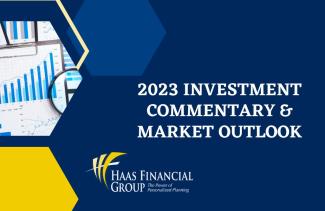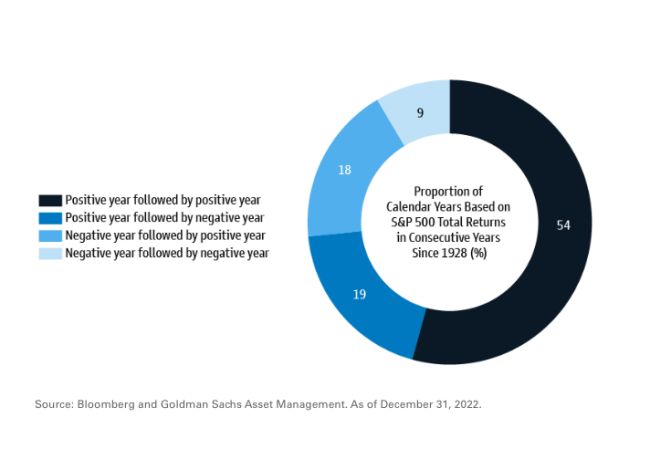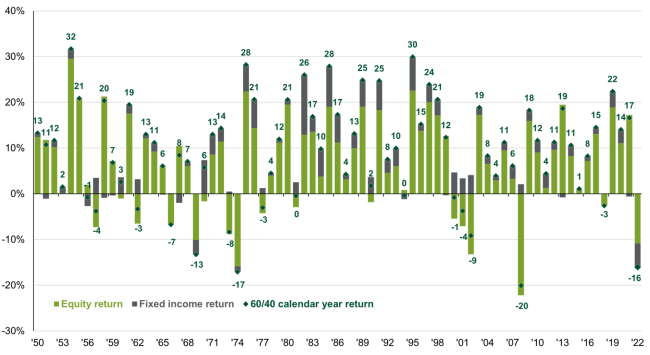
2023 HFG Investment Commentary and Outlook
As you may know, we dig through and read A LOT of investment commentary and outlooks from many big investment providers. We aggregate this information and then use it to challenge our existing portfolio holdings and allocations. Ultimately, this either confirms that we’re still positioned appropriately, or it may lead us to make tweaks to our investment holdings or overall allocations.
2022 was an incredibly challenging year for almost all investments and while we may be fighting a lot of the same factors in 2023, we believe there are some silver linings that should set us up for a much better year this year. Only time will tell!
The S&P 500’s performance in 2022 was its seventh worst since inception and the third worst since 2000. Volatility, lack of earnings growth, and a high cost of capital may pose headwinds for US stocks in 2023, but there is a silver lining: since 1928, the index has only delivered back-to-back negative returns eight times. History may be on investors’ side as positive S&P 500 returns have followed a down year more than two-thirds of the time.
Diversification faced a challenging year in 2022, with the 60/40 portfolio (60% S&P 500 and 40% Bloomberg U.S. Aggregate Bond index) down 16% on a total return basis. Not only was it the worst performance since 2008, but also it was the first year since 1974 in which both stocks and bonds declined.
Although investors have come to expect a negative stock/bond correlation, in which stock prices and bond prices move in opposite directions, that was not the case last year. Persistent inflation caused the Federal Reserve to raise rates much more aggressively than initially anticipated, increasing the federal funds rates by 425 basis points (or 4.25%) over the course of the year. Rates are the common thread between how stocks and bonds are valued, so higher rates put pressure on both stocks and bonds.
However, this dynamic could change in 2023. Inflation appears to have peaked and is subsiding, as evidenced by normalizing commodity prices and supply chains, and waning demand for goods in favor of services. This should allow the Fed to end its rate hiking cycle in the coming months, limiting the rise in yields this year. In fact, a broadly forecasted recession would likely push yields down, supporting bond prices at a time when equities might struggle (bond yields and bond prices move in opposite directions).
The dismal market performance and valuation reset in 2022 could set up a diversified portfolio for better returns this year and in years ahead. Last year was the worst year since 2008, but 2009 boasted positive returns for both stocks and bonds, and the 60/40 portfolio was up 18%. In 1974, both stocks and bonds were down, but both rebounded in 1975 for a 28% return on the 60/40. Challenges remained in both 1975 and 2009, but markets typically begin to recover before economic growth, the labor market, and earnings bottom. Moving forward, the reset we saw in valuations in 2022 create a more attractive starting point for the years ahead.
For long-term investors, buying the dips – in both stocks and bonds—could become attractive in 2023, and diversification could stage a comeback.
JPMorgan Blog Post
60/40 annual return decomposition
Total returns, 1950 – present
Source: FactSet, Standard & Poor’s, Robert Shiller, Yale University, Bloomberg, Ibbotson/Strategas, J.P. Morgan Asset Management.
The 60/40 portfolio is 60% invested in S&P 500 Total Return Index and 40% invested in Bloomberg U.S. Aggregate Total Return Index. S&P 500 returns from 1950 – 1970 are estimated using the Shiller S&P Composite. U.S. fixed income total returns from 1950 – 1975 are estimated using data from Strategas/Ibbotson. The portfolio is rebalanced annually. Guide to the Markets – U.S. Data are as of December 31, 2022.
Investment advice offered through Great Valley Advisor Group, a Registered Investment Advisor. Great Valley Advisor Group and Haas Financial Group are separate entities. This is not intended to be used as tax or legal advice. Please consult a tax or legal professional for specific information and advice. Tracking # T005271





